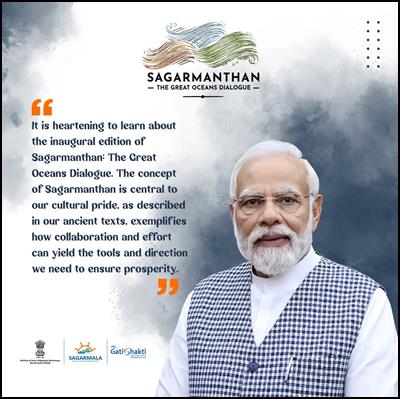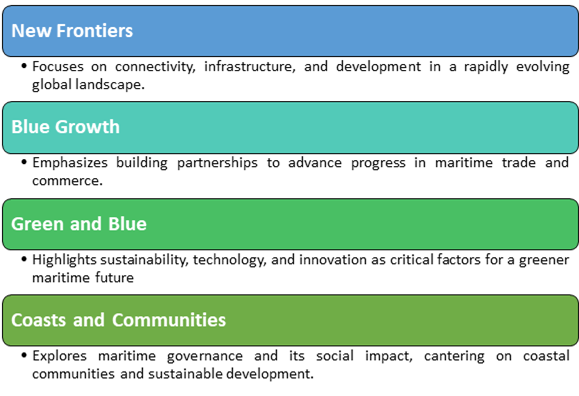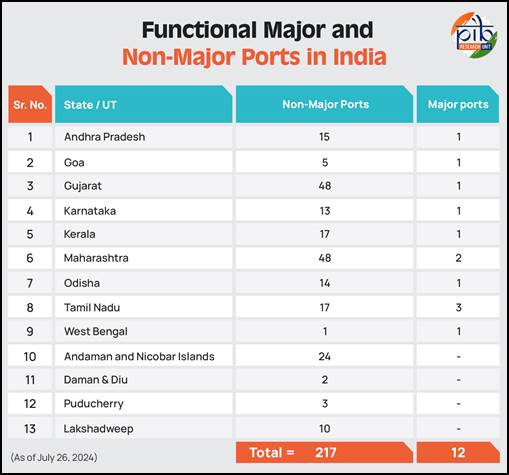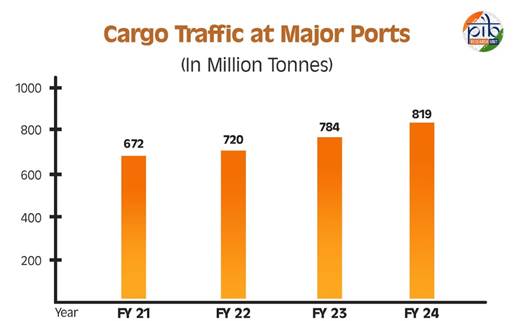Ministry of Ports, Shipping and Waterways
Sagarmanthan 2024: India’s Maritime Vision
819 MT of cargo processed, with green and smart port initiatives at the forefront
प्रविष्टि तिथि:
19 NOV 2024 4:47PM by PIB Delhi
Introduction
India’s maritime legacy is as vast and dynamic as its 7,500-kilometer coastline, which anchors 12 major ports and over 200 minor ones. Positioned along the world’s busiest shipping routes, India is not just a key trading hub but a rising global power. In 2023, the nation contributed 16 percent of global growth, and according to some estimates, it is on course to become the third-largest economy within the next three years. As India ascends the global stage, its maritime sector emerges as a linchpin for commerce, connectivity, and international cooperation.

This growing influence brings with it both opportunity and responsibility. To lead in global maritime governance, India must foster deeper engagement with policymakers, business leaders, and thought leaders. By shaping conversations around sustainable practices and forward-thinking strategies, India can redefine its role in the maritime domain.
Against this backdrop, the first edition of ‘Sagarmanthan: The Great Oceans Dialogue’ takes centre stage. Being held from November 18 to 19 in New Delhi, this landmark event is South Asia’s largest maritime thought leadership forum. Organized by the Ministry of Ports, Shipping and Waterways (MoPSW) in partnership with the Observer Research Foundation (ORF), Sagarmanthan offers a premier platform for global leaders, policymakers, and visionaries to share insights and shape the future of the marine sector. With critical themes spanning the blue economy, global supply chains, maritime logistics, and sustainable growth, the dialogue aims to chart a bold, actionable course for a vibrant and future-ready maritime ecosystem.
Sagarmanthan: Thematic Pillars
Sagarmanthan is designed to facilitate in-depth discussions on key aspects of the blue economy and maritime governance. Its structure revolves around four interconnected themes, each addressing critical challenges and opportunities shaping the future of the oceans.
Four central themes are:

Overview of India's Maritime Sector
India’s maritime sector serves as the backbone of its trade and commerce, handling around 95% of the country’s trade by volume and 70% by value. With 12 major ports and over 200 notified minor and intermediate ports, the country’s port infrastructure underpins its growing economy. As the sixteenth-largest maritime nation in the world, India occupies a key position on global shipping lanes. Most cargo ships traveling between East Asia and destinations like America, Europe, and Africa traverse Indian waters, highlighting the nation’s strategic importance.

Source: https://sansad.in/getFile/loksabhaquestions/annex/182/AU831_DTHWKp.pdf?source=pqals
The sector’s contributions extend beyond trade. India boasts a fleet of 1,530 ships sailing under its flag as of 2023, a testament to its growing presence in global shipping. Additionally, the country is the third-largest in the world in terms of ship recycling by tonnage, underscoring its role in sustainable maritime practices and the global supply chain. This prominence complements the nation’s efforts to modernize and expand its port infrastructure. Between 2014-15 and 2023-24, major ports increased their annual cargo-handling capacity from 871.52 million tonnes to 1,629.86 million tonnes, reflecting an impressive growth of 87.01%. In the financial year 2024 alone, Indian ports managed 819.22 million tonnes of cargo, a 4.45% rise from the previous year. This growth aligns with a surge in merchandise exports, which climbed to USD 451 billion in FY23 from USD 417 billion the year before.

Source: https://www.ibef.org/industry/ports-india-shipping
The Indian Government has played a crucial role in fostering this growth. Policies such as allowing 100% Foreign Direct Investment (FDI) under the automatic route for port and harbour projects and offering a 10-year tax holiday to enterprises engaged in port development have bolstered the sector. These measures, combined with the nation’s expanding trade networks, position India’s maritime industry as a cornerstone of its economic ambitions.
Some of the major recent developments and initiatives:
- In 2023-24, major Indian ports reduced container turnaround time to 22.57 hours, exceeding global benchmarks. Paradip Port earned ₹1,570 crore (US$ 188 million) with a 21% rise in net surplus, while Jawaharlal Nehru Port reported a net surplus of ₹1,263.94 crore (US$ 151 million).
- India plans to establish a new shipping company to expand its fleet by at least 1,000 ships within a decade. This initiative aims to cut foreign freight costs by one-third by 2047 and increase trade revenue, with joint ownership involving state-run corporations and foreign firms.
- Paradip Port became India's largest major port by cargo volume in FY24, handling 145.38 million tonnes. It surpassed Deendayal Port Authority due to enhanced operational efficiency, record coastal shipping traffic, and a surge in thermal coal shipments.
- India has outlined investments of US$ 82 billion in port infrastructure projects by 2035 to bolster the maritime sector.
- In June 2024, the Government approved the establishment of a major port at Vadhavan, Maharashtra, with an estimated cost of ₹76,220 crore (US$ 9.14 billion). This project aims to expand EXIM trade capacity and attract public-private partnerships for infrastructure development.
- In July 2024, the Government updated the Shipbuilding Financial Assistance Policy (SBFAP), providing ₹337 crore (US$ 40.40 million) in financial aid to boost India’s shipbuilding competitiveness. Since the policy's launch, 313 vessel orders worth ₹10,500 crore (US$ 1.26 billion) have been secured.
- The ‘Panch Karma Sankalp,’ announced in May 2024, includes five major announcements focusing on green shipping and digitization: MoPSW will provide 30% financial support for promoting Green Shipping; under the Green Tug Transition Programme, Jawaharlal Nehru Port, VO Chidambaranar Port, Paradip Port, and Deendayal Port will procure two green tugs each; Deendayal Port and VO Chidambaranar Port, Tuticorin will be developed as Green Hydrogen Hubs; a Single Window Portal will be established to facilitate and monitor river and sea cruises; and Jawaharlal Nehru Port and VO Chidambaranar Port, Tuticorin will be transformed into smart ports by next year.
Government Schemes in the Maritime Sector
The Indian maritime sector plays a critical role in supporting the country’s trade and economic growth. Several government schemes have been launched to modernize infrastructure, enhance port connectivity, and promote sustainability in the sector. These initiatives aim to strengthen India’s position as a global maritime hub and improve its efficiency across various maritime segments. Here are some of the major schemes in the maritime sector:
Sagarmala Programme
The Sagarmala Programme is a flagship initiative by the Ministry of Ports, Shipping, and Waterways aimed at driving port-led development across India. With a focus on leveraging India’s 7,500 km coastline and 14,500 km of navigable waterways, the scheme supports various port infrastructure projects, coastal development, and connectivity enhancements. Financial assistance is provided to State/UT Governments for projects like coastal berths, road and rail connectivity, fish harbours, skill development, cruise terminals, and Ro-Pax ferry services. As of July 26, 2024, 130 projects with a total allocation of ₹3,714 crore have been sanctioned.
Maritime India Vision (MIV) 2030
To position India as a global maritime leader, the Ministry of Ports, Shipping, and Waterways has launched Maritime India Vision 2030 (MIV 2030). This comprehensive blueprint aims to accelerate and harmonize the growth of India’s maritime sector over the next decade. Developed in consultation with over 350 public and private stakeholders, MIV 2030 encompasses more than 150 initiatives across ten key themes, addressing all areas of the maritime sector, from ports and shipyards to inland waterways and trade bodies.
Inland Waterways Development
The Inland Waterways Authority of India (IWAI) has identified 26 new national waterways, following feasibility studies to make them navigable. These new routes will provide an alternative mode of transportation, easing the load on congested road and rail networks and promoting sustainable, cost-effective transport options for various regions.
Green Tug Transition Program (GTTP)
The Green Tug Transition Program (GTTP) aims to phase out conventional, fuel-based harbour tugs at Indian major ports. These will be replaced with environmentally friendly tugs powered by cleaner, sustainable fuels. The transition is set to be completed by 2040, ensuring a fully eco-friendly fleet across the country’s major ports.
Conclusion
In conclusion, India's maritime sector is poised for significant growth, underscored by its strategic initiatives and government schemes. The first edition of Sagarmanthan: The Great Oceans Dialogue has further cemented India's commitment to becoming a global maritime leader, bringing together stakeholders to discuss key themes such as sustainability, connectivity, and governance. With programs like the Sagarmala Programme, Maritime India Vision 2030, and the Green Tug Transition Program, the nation is taking decisive steps to modernize its infrastructure, promote green shipping, and enhance port connectivity. These efforts, coupled with the insights shared at Sagarmanthan, will propel India’s maritime sector toward a sustainable, innovative, and future-ready ecosystem, ensuring its place as a central player in the global maritime landscape.
References:
Click here to download PDF
*******
Santosh Kumar/ Ritu Kataria/ Saurabh Kalia
(रिलीज़ आईडी: 2074644)
आगंतुक पटल : 7745